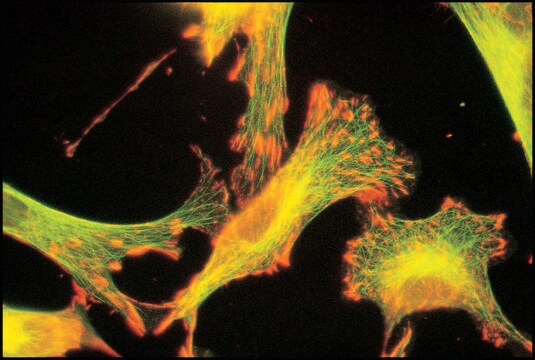T3320
Anti-γ-Tubulin (AK-15) antibody produced in rabbit

IgG fraction of antiserum, buffered aqueous solution
About This Item
ICC
WB
microarray: suitable
western blot: 1:1,000 using whole cell extract of the human epitheloid carcinoma HeLa cell line.
western blot: 1:5,000 using Xenopus eggs extract
Recommended Products
biological source
rabbit
Quality Level
conjugate
unconjugated
antibody form
IgG fraction of antiserum
antibody product type
primary antibodies
clone
polyclonal
form
buffered aqueous solution
mol wt
antigen 48 kDa
species reactivity
human, frog, rat
enhanced validation
independent
Learn more about Antibody Enhanced Validation
technique(s)
immunocytochemistry: 1:1,000 using methanol-acetone fixed, cultured rat, RAT-2 cells
microarray: suitable
western blot: 1:1,000 using whole cell extract of the human epitheloid carcinoma HeLa cell line.
western blot: 1:5,000 using Xenopus eggs extract
UniProt accession no.
shipped in
dry ice
storage temp.
−20°C
target post-translational modification
unmodified
Gene Information
human ... TUBG1(7283) , TUBG2(27175)
rat ... Tubg1(252921) , Tubg2(680991)
General description
Application
- Western blot.
- Immunofluorescence.
- western blotting
- immunocytochemistry (immunofluorescence staining
- immunofluorescence
Biochem/physiol Actions
Physical form
Disclaimer
Not finding the right product?
Try our Product Selector Tool.
Storage Class Code
10 - Combustible liquids
WGK
WGK 3
Flash Point(F)
Not applicable
Flash Point(C)
Not applicable
Choose from one of the most recent versions:
Already Own This Product?
Find documentation for the products that you have recently purchased in the Document Library.
Customers Also Viewed
Articles
Microtubules of the eukaryotic cytoskeleton are composed of a heterodimer of α- and β-tubulin. In addition to α-and β-tubulin, several other tubulins have been identified, bringing the number of distinct tubulin classes to seven.
Our team of scientists has experience in all areas of research including Life Science, Material Science, Chemical Synthesis, Chromatography, Analytical and many others.
Contact Technical Service







